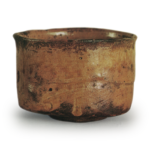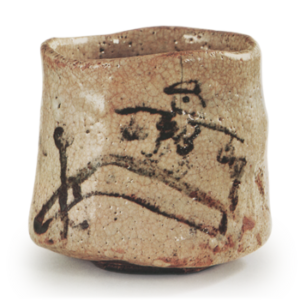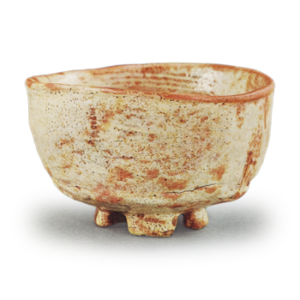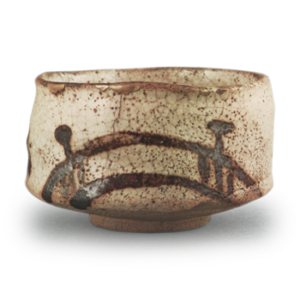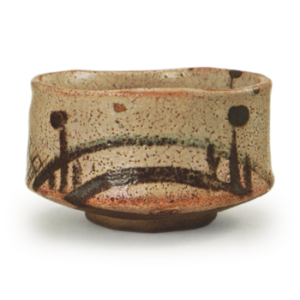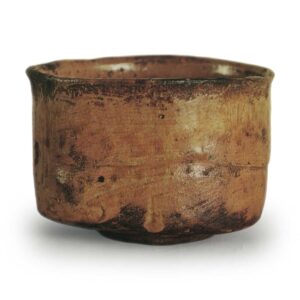
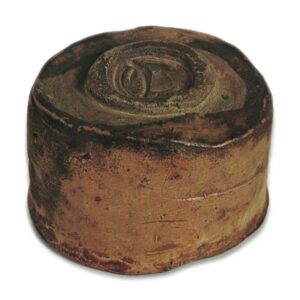
Height: 8.5-8.9cm
Diameter: 12.4-13.1cm
Outer diameter of foot ring: 6.0-6.6cm
Height of foot ring: 0.8-0.9cm
Of the yellow Seto ware that still exists today, it is said that this “Asahina” bowl is the only one that was originally made as a tea bowl. In addition to this “Asahina” bowl, three other yellow Seto ware bowls are listed, but as is commonly believed, they were probably not made as tea bowls, but as side dishes.
The way they were made, with the shape formed on the potter’s wheel and then scraped to look hand-made, is exactly the same as Shino tea bowls, and the shape of the side ridges in particular is very similar to the way they were made for Hatsune.
The foot ring, which is carved out, is strong, and the carving within the foot ring is particularly bold. The carving of the bow-shaped pattern on the left side is not a kiln mark, but rather a deliberate design. The flesh of the foot ring is also quite strong, and the carving that wraps around the waist in a beveled pattern is also well-executed.
The body, which rises almost in a straight line, is sharply turned outwards at the rim, and the shape of the side of this part is very masculine. There is a single horizontal line of incised marks on the body, and this too is a deliberate design feature that emphasizes the sense of power. The outside of the body is mostly scraped with horizontal lines, and vertical lines are more common around the mouth. The inside of the bowl has a slightly irregular circular tea-drip well, and the overall spaciousness is similar to Setoguro ware.
The clay body is made of mugusa clay, and the entire surface, except for the foot ring, is covered in yellow glaze. However, the glaze on the outside is thinner than the glaze on the inside, and the area around the rim and foot ring is particularly thin, so it shows a dark brown color. The glaze on the inside is slightly thicker, and has a so-called deep-fried tofu-like texture, with a few small feldspar grains visible. In addition, a slightly yellowish glaze has run down the side of the body, and this part has a particularly strong sheen.
As I have already mentioned, the overall appearance of this piece is almost identical to that of Shino ware, but the glaze is not as thick as that of Shino ware, and the rough, rugged appearance of this piece appeals to the eye.
Asahina is the name given to this piece by Sotatsu, but the reason for this is unclear. It is said that the name is derived from Asahina Saburo Yoshihide, who was known as a man of courage from ancient times, and the name is written directly in red lacquer on the side of the foot ring: “Asahina”.
The inscription “Asaina Chawan Sotan” on the front of the inner box lid is probably by Sen’o, while the “Sokatsu-go Asahina-hachi (signature)” on the back of the lid is by Esumi. In addition, a letter of recommendation from Nittakusai is attached as a hanging scroll, and the text of the letter is as follows
I have been waiting for the opportunity to see your promised tea bowl, and I am very impressed with it. I hope we can meet soon. With great respect, September 13th, Takaku (signature) Mitsui Hachiemon-sama, Nittakusai
It is thought that it was probably in the possession of Sōtan and passed down through the Sen family, but it was later transferred to the Mitsui family and passed down through that family.

